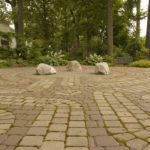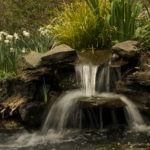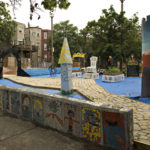Inspiration Point
Creating change through connection and reflection
Inspiration Point didn’t start in a design lab or boardroom. It started in the human heart—with people from different walks of life following the flight path of an eagle. They all started in different spots, but they all ended up at the same place. That’s how the location of Inspiration Point—our very first Nature Sacred space—was chosen.

Nature Sacred’s flagship project
Inspiration Point is nestled in the woods overlooking a creek on the 33-acre grounds of the Chesapeake Bay Foundation (CBF) in Annapolis, Maryland. When the non-profit was planning a new headquarters, critical to its mission of protecting and restoring the vast Chesapeake Bay watershed was incorporating a refuge where people could retreat from heated discussions and regroup. CBF is the locus of environmental policy and change relating to the bay. And change can be a conflict-ridden process. So a space close to the sustainable building out in nature, which we know to be calming and inspiring, seemed like a good solution to foster the foundation’s cause.

CBF President Will Baker charged Firesoul Don Baugh, then the foundation’s vice president of education, with assembling a committee to choose the site.
An organic process
Their decision-making process wasn’t exactly what we had in mind. But it ended up informing what were to become cornerstone concepts in the Nature Sacred site development process. That each designated place must be open and sacred; embody the character of the community it serves; involve that community throughout the planning and construction process; and adapt and evolve. (Learn more about our product design here.)
The traditional planning process he knew consisted of setting goals, constructing structures to support those goals and creating incentives. But the CBF team process was way more organic. Baugh made a list of places for the committee to visit. He chose them based on two criteria: all were sites of Native American villages and eagles’ nests.
Native Americans lived in the Chesapeake Bay region for over 10,000 years before European settlers. They chose special places with access to the land’s resources and treasures, close to water and food sources and sheltered from the elements. Like the Native Americans did, bald eagles also choose where they settle, generally tall trees in quiet places.

Each person set out, at different times and starting points, to find a site that felt right to them. They kayaked and canoed, hiked and biked. While there were several stunning spots, they all amazingly favored the same one.
Remote but open
Rather than along the bay’s shoreline, the spot chosen was overlooking a creek. It was remote but open—ideal for decompressing from stress and work-pressures.
Basing a site plan on the flying patterns of birds probably wouldn’t fly in a traditional business plan. But it made sense to these stakeholders and suited this site perfectly. So we went with it!
Like all our Sacred Places, we designed Inspiration Point to have a portal, and pathway through the woods that led straight from CBF’s headquarters to the destination, and a bench perched on the creek bank. The path then circles back to the building alongside the creek, passing small clearings with more benches for tours of visitors and students.

The path is flat and meets American Disability Act (ADA) requirements, so people of all abilities can enjoy the space. Covered in fine gravel that allows water to seep into the ground, it’s also earth friendly. We designed a lush sense of surround, layered with native flowers and foliage, among existing trees to create a feeling of intimacy and escape from the real world.
I will tell you why I love this place. I love this place because no matter where I go, I can take it with me. No matter what.
—Anonymous Journal Entry
In a pickle
When it came time to build the bench for Inspiration Point, builder and Firesoul Chuck Foster of CBF had a tall order. It needed to weather the elements, provide a comfortable, splinter-free seat for six people at a time and thousands to sit on over the years– and somehow embody the project’s ethos.
The project’s stakeholders were considering commercial benches. But the opportunity arose to access swimming-pool sized pickle vats—yes, pickles! Vats that were no longer in demand—and we pounced on it. The reclaimed wood was perfect. Benches built from old-growth, tight-grained trees and, hey, they’re pickled, so were sure to last.

Stakeholders agreed that giving the old wood new life fit with our earth-friendly philosophy. More important, it served as a metaphor for the kind of revitalization TKF hoped to instill in all its projects and for all people who visited these sacred sites.
In fact, we liked this bench and what it stood for it so much it became the prototype for all our benches.
Someday I hope to have the strength and serenity of a pickle barrel. May this place and this bench grant me that strength. May God grant me the serenity.
—Anonymous Journal Entry
Reflection and connection
CBF helps connect people to nature by educating them and encouraging them to experience that connection in a meaningful way. How? By exposing them to places that are so breathtakingly beautiful and tranquil they make an instant and lasting impression, according to Firesoul Baugh.
We’re grateful to have worked with CBF to create this Nature Sacred site and do exactly that. CBF later designated three more Nature Sacred sites along the bay at their educational centers. All of them welcome (X number of visitors?) yearly.

Revelation and inspiration
What emerged from this process for us at TKF was a new understanding about what sacred and open really meant and the intrinsic role nature played. We didn’t have strict definitions going into this first project—but we’d have been in trouble if we had. We learned that a project like this has to emerge. That the power must come from the community, and the decision be a collective, intuitive one. That you need open minds and no agendas. That the power also comes from nature. Because it is elemental in everything. Then the magic happens.




